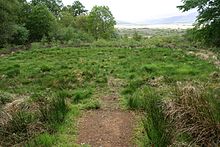
In archaeology, a hut circle is a circular or oval depression in the ground which may or may not have a low stone wall around it that used to be the foundation of a round house. The superstructure of such a house would have been made of timber and thatch. They are numerous in parts of upland Britain and most date to around the 2nd century BC. [1][2]
Hut circles are usually around 5 to 25 feet (1.5 to 7.6 m) in internal diameter, the rocks themselves being 2–3 feet (0.61–0.91 m) wide and around 3 feet (0.91 m) high. Hut circles were also almost certainly covered by conical rounded roofs and supported by posts that were internal and sometimes external.[1]
- ^ a b Hemp, W. J.; Gresham, C. A. (1944). "Hut-circles in North-west Wales". Antiquity. 18 (72): 183–196. doi:10.1017/S0003598X00018627.
- ^ Darvill, Timothy (2008). Oxford Concise Dictionary of Archaeology (2nd ed.). Oxford and New York: Oxford University Press. p. 202. ISBN 978-0-19-953404-3.